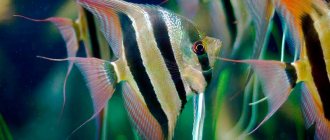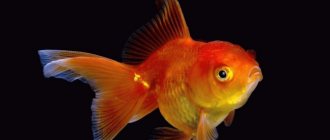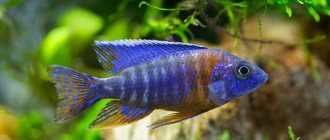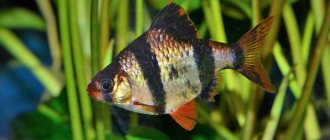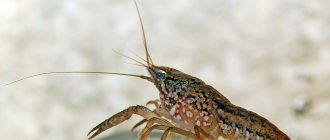Angelfish are beautiful and elegant cichlids. Their homeland is South America. Abroad, they are called angels for their beautiful sailing fins. Angelfish appeared in home aquariums a long time ago and have earned recognition and respect. Angelfish have a well-developed intellect, they are unpretentious in their maintenance and, among other things, they take care of their offspring.
Latin name : Pterophyllum scalare.
Order: Perciformes.
Family: Cichlids.
Suitable water temperature: 22-27 °C.
Acidity: 6 – 7.5 pH.
Hardness dH: up to 10.
Compatibility: Angelfish live peacefully with swordtails, danios, gouramis, lalius, pelvicachromis pulchera, small catfish, tetras and non-aggressive cichlids.
You should not keep angelfish with guppies, goldfish, aggressive cichlids, barbs, and discus.
Description of aquarium fish
Angelfish have a round body that is flattened at the sides. The anal and dorsal fins are long and give the fish a crescent shape. In nature, their body is silver with black transverse stripes. As a result of selection, many different colors were obtained: red, black, marbled, zebra, two-color, blue, pink and others.
Adults in a spacious aquarium grow quite large. The length of the fish reaches 15 cm, and the height is 25 cm. To make the fish comfortable, you need a large aquarium. So for a pair of scalars there should be 100 liters. In good conditions they live for about 10 years, or even more.
Origin
Once you find yourself in a pet store, you can’t help but want to admire the variety of colors of angelfish. In large aquariums, flat fish in yellow, leopard, yellow-pink and many other colors swim proudly.
But in fact, they are all artificially bred. The veiled angelfish, which attracts attention thanks to its elongated upper and anal fin, is no exception. You look at her, a crescent moon is floating across the aquarium, all so majestic and proud. Upon closer examination, it turns out that the “crescent” is not so majestic, and requires quite significant care.
But we digress, let's return to the origin of this fish. It is American and lives safely in the waters of the Amazon and Orinoco. It is obvious from the names of the rivers: the angelfish came to us from South America.
Conditions of detention
Comfortable water temperature for rolling pins is 22-27 degrees. But despite this, fish can survive at temperatures of 16 degrees. They tolerate temperature rises up to 35 degrees well. As for water parameters, they can live in both soft and hard water. But dH is considered more comfortable: up to 10°, Ph: 6-7.5.
To live comfortably in an aquarium, you must install a filter and an aerator. Every week you should change 30% of the water to fresh.
It is not necessary to cover the aquarium with a cover glass or lid. Angelfish are inactive and will not jump out of the water.
As for lighting, it should be moderate. It is very good if plants float on the surface, for example, hornwort, pistia, riccia. If the light is bright, the fish will hide and get scared. In the aquarium, plant long-stemmed plants, such as spiral vallisneria, ludwigia, and bacopa. This aquarium imitates the natural habitat of cichlids.
Angelfish do not need driftwood, stones, or grottoes, but they can be used as decorations. When decorating the jar, be sure to leave an open space for floating.
It is better to keep angelfish in a flock. Strong and large couples will dominate, and the rest will hide from them.
What to feed the angelfish
Live, frozen and dry food is used as food. It is better to use high-quality flakes as the main source of nutrition. Artemia and koretra will serve as additional food. Angelfish, like other types of fish, love to eat and do not know when to stop. You cannot overfeed them.
As for bloodworms, it is better to refuse them. The slightest overfeeding of this food threatens intestinal bloating. In this case, pink bubbles become visible from the anus of the fish.
If there is no plant food in the diet, then cichlids begin to tear off leaves from tender plants. To prevent this from happening, feed them food with spirulina.
Nutrition
The marbled veiled angelfish, its leopard relative and the simplest “country” angelfish are cichlids. Even if they are very small, they are predators who love to feast on live food.
Some owners believe that feeding live bloodworms is inhumane, which is why they prefer to buy frozen briquettes. But angelfish must receive live food:
- Small bloodworms and tubifex are among the favorite “dishes” of representatives of the species.
- Aquarium inhabitants will not disdain boiled beef heart, cut into small pieces, or chicken breast in minimal quantities.
- When it comes to dry food, choose assorted flakes. They contain both plant components and animal origin. Another option is to purchase food specifically formulated for angelfish. It comes in small to medium granules, depending on the size of the fish.
Please do not overfeed your aquarium beauties. They love to eat, as they will testify by swimming up to the glass and showing with all their appearance how hungry they are. But angelfish must know their food intake - a small pinch twice a day, the amount of which depends on how large the fish lives in the aquarium. Otherwise, instead of a beautiful “crescent” with luxurious fins, lush “pancakes” will float around the tank.
Types of angelfish
Thanks to selection, many colors have been obtained. Below we will look at the most popular of them.
Common angelfish
The average size of this fish is 22 cm. The color is silver. In mature individuals, the forehead and back have a darker shade than the body. Previously, this species was popular among aquarists, but recently aquarium lovers have given preference to new breeding species.
Leopold's angelfish
Compared to its relatives, this is a small fish. The length of its body reaches only 15 cm. Because of the long front part, the angelfish is called “long-nosed”. The body is brown with dark stripes. The fins look proportional relative to the body. During the breeding season, a school of fish divides into pairs, and when the fry hatch, the fish begin to swim in a school again.
Diamond angelfish
The body of this species of fish is bright silver in color. Some individuals have dark stripes on their bodies. The fins are transparent, the color of the scales plays different colors in the light.
Platinum angelfish
This name was given to the fish because of its light silver body color.
Leopard angelfish
The body of fish of this species is equally colored black and silver. The spots have different shapes. To make the fish comfortable, you will need a large aquarium and a lot of free space.
Angelfish bicolor
Fish of this species have a two-color body - silver and black. Both colors are separated by a clear boundary. There are no stripes on the body.
Angelfish altum (high-finned)
In the wild, some angelfish grow up to 45 cm in height. The high-finned angelfish in its appearance resembles an ordinary one, but unlike the ordinary one, a clear pattern is noticeable on the body. To keep this type of cichlid you need a spacious aquarium.
Paraiba angelfish (phantom)
These are fish with a double asexual gene. Some aquarists call the blue pearl angelfish this way.
Pearl angelfish
The beautiful iridescent color is due to genetics. When the light is on, the scales of cichlids shimmer with bright reflections.
Red Devil
The main body color is red, but small spots of other colors may be present. This type of cichlid is peaceful and does not pose a danger to other aquarium fish.
Blue Angel
Blue angelfish with transparent fins are a real decoration of aquariums. The color of her body is rich and has no stripes.
Golden angelfish
The fish are unpretentious. There are golden spots of different sizes on the light silver body. Some individuals have almost no yellow tint, and in some it occupies most of the body. The fins are large and transparent.
Koi angelfish
Black strokes are noticeable on the white body; the head, however, like other parts of the body, can have a bright red or orange tint. The cost of an aquarium fish depends on the size of the bright spot. The smaller it is, the more expensive the fish. Koi angelfish cichlids are never the same. Their pattern is always different.
Marble angelfish
This species is smaller than ordinary angelfish. The body has black and silver colors, spots and various stripes. Because of the shapeless spots reminiscent of rock, the cichlid was nicknamed marble.
Zebra
The body of the striped angelfish is decorated with black and white stripes. There are more than four stripes and they all have a clear outline. Variety: blue zebra.
Veiled angelfish
The fins of representatives of this species are elongated, translucent and curved. Their color and pattern may vary. Individuals with veil fins should not be kept with macropods, predatory cichlids, or barbs. Even small neons and minors can bite the large fins of angelfish. It is better to choose peaceful bottom-dwelling fish as neighbors.
Black angelfish
Breeders bred this species a long time ago and since then it has been found in home aquariums. In addition to purely black specimens, there are fish on sale with a silver or gray tint on the abdomen. They are called "black velvet".
Pink glowing angelfish
This type of fish exists thanks to genetic engineering. It is rarely found in aquariums because it is expensive. Those who kept the fish say that it does not live long and cannot produce offspring.
Compatibility
Angelfish are often kept with other fish, but when choosing neighbors, the aggressive nature and habits of the predator are taken into account. They eat fry, shrimp, crustaceans, and small fish. Neighbors must be the same size or larger.
At a young age, fish stay in a school. This makes it easier for them to resist large aquarium fish. As they grow, they divide into small groups and then form pairs.
Despite its belligerence, the angelfish fish is quite shy. She is afraid of loud sounds, bangs, sudden movements, and flashing lights.
Ideal neighbors for angelfish: swordfish, platies, mollies, guppies, gourami, congo, erythrozonus.
But proximity to cardinals, microrasboras, neons, barbs, and thorns should be avoided. Angelfish do not get along well with other predators. They can become prey to other aggressive fish. With such proximity, fins and tails suffer, which are torn off by other predators.
How to distinguish a male from a female
You can distinguish a male from a female at the age of 9-12 months. Until this age, no one will be able to tell whether it is a male or a female. When purchasing juveniles, try to choose a pair of larger fish and a pair of slightly smaller fish. It is quite possible that those who are larger will turn out to be males, and those who are smaller will be females.
In general, determining gender requires practice. Those who have kept an angelfish for more than one year will quickly determine the gender, but a beginner will have a difficult time. You will need to observe your pets to see the differences.
Behavior is the first thing to pay attention to. The behavior of males resembles the behavior of boys, and females resemble the behavior of girls. This becomes especially noticeable when the fish split into pairs.
Body structure is the second distinguishing feature. Males have a fatty bump on their forehead, while females do not have one. Males have a convex forehead, while females have a sunken forehead. The boys' body is powerful, and stripes are visible on the back of the long fins.
be noticed during spawning . During this period, the male has a sharp and narrow vas deferens, and the female has a short and wide ovipositor.
Natural color
This is interesting to know for all lovers of beautiful fish. Its natural color is not so beautiful; it can easily be called “rustic”. Where does this comparison come from? Reminiscent of the color of the simplest outbred tabby cat, which is popularly called country cats.
The common flatfish from which the veiled angelfish is descended is silvery and striped. It sounds very beautiful - a silver fish, but in fact its main color is gray, with vertical black stripes.
Breeding angelfish
In a spacious aquarium with comfortable conditions, fish spawn in a common aquarium. Most often this happens after changing the water and increasing the temperature by several degrees. Plants with wide leaves must grow in the aquarium; the female will lay eggs on them. But it also happens that instead of leaves, she chooses the surface of some kind of shelter, glass or filter tube. The place they like is thoroughly cleaned, only then does spawning begin. During spawning, the female lays 500-1000 eggs (it all depends on the age and size of the female).
The incubation period is two days. Parents take care of the eggs: they clean them of debris and remove dead ones. When the larvae hatch, the parents carry them in their mouths to another place. For the next week, under the supervision of their parents, the larvae hang on the leaf. When they swim, they can be given nauplii and nematodes. As for dry food, it is better not to use it. Due to such a diet, the number of dead fry will increase significantly. In the morning and evening, the aquarium should be cleaned of uneaten food and other dirt.
Because angelfish are kept with other species, they become stressed and eat their young. At fish farms, producers are removed from caviar. Because of this, finding a couple who will conscientiously care for their offspring is difficult, if not impossible. If you intend to raise the fry, then after spawning, tear off the sheet with eggs and place it in another aquarium. To prevent the eggs from becoming covered with fungus, add methylene blue to the water. Remove white caviar daily.
Reproduction and lifespan
Angelfish are paired fish. Finding themselves alone, they (if possible) strive to find a partner. Once they form a pair, they become inseparable. Experts say that affection lasts a lifetime. It is well known that in the event of the loss of a partner, fish experience stress, stop eating for a long time, and can get sick.
It is almost impossible to artificially create a pair, to introduce a male to a female, for two reasons. Angelfish have almost no gender differences. Even a specialist can make a mistake in determining the sex of a fish. The second reason is that it is completely unknown what influences the liking of fish, what signs they use to choose a partner.
An aquarist who intends to get offspring from angelfish releases a group of fish into the aquarium and observes how the fish pairs develop. But even here an error may occur. In the event of a shortage of men or women, fish left without a pair can imitate the behavior of an individual of the opposite sex.
At one year of age, angelfish are ready to reproduce. When approaching this age, the fish find a mate. The further process cannot be completed without human help. The aquarist places the future parents in the spawning aquarium. To initiate spawning, the water in the aquarium is raised to 28 °C and the fish ration is increased.
The aquarium where the fish were placed should contain broad-leaved aquatic plants. The female begins to clean the leaf - this is preparing a platform for laying eggs. angelfish eggs are laid on it . A nearby male releases his reproductive products.
Within a few hours, the female brings 300 or more eggs. Often, owners take the eggs away from their parents and place them in a separate container. The reason for these actions is simple. Angelfish, in principle, are caring parents: they ensure that the eggs are washed with water and drive away strangers. But sometimes the predatory instinct takes over, and there is nothing left of the caviar.
After two days, incubation ends and larvae appear. For some time they feed on the nutrients stored in the yolk sac. Once the starting supply is complete, the angelfish fry begin to feed on their own.
In a month, future angelfish will be visible in the fry. Angelfish can safely be called aquarium long-livers. Experienced aquarists claim that fish can live 10 years or more with decent care and a varied diet.
